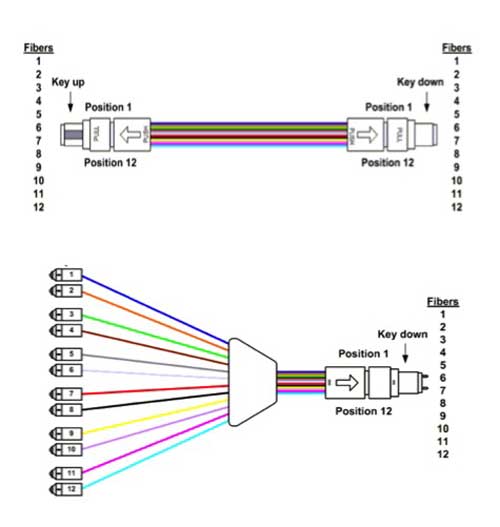November 09, 2016
As new network architectures continue to demand ever higher speed, 40Gbps and 100Gbps Ethernet links are rapidly coming on line. In fact, volume is starting to build and switch port as well as transceiver prices are dropping rapidly. There are many new form factors for optical transceivers supporting a variety of transmission distances and fiber types. But they are not the prior focus of this post. Today, we’ll mainly bring two major trends to you. One major trend is the use of multiple parallel optical paths to achieve the total 40Gbps or 100Gbps interface transfer rate. The other is using multiple wavelengths and integrated wavelength division multiplexing to achieve multiple paths on single fibers.
Concerning modal dispersion when the speed is at or above 25Gbps, it is very challenging to achieve distance of more than 5 or 10 meters on multimode fibers. Therefore, most multimode transceiver implementations at 40G/100G use multiple parallel links each running at rates of 10Gbps or 25Gbps. While some may be familiar with the use of multi-fiber ribbon cables terminated with MPO connectors for interconnection between with fiber patch panels, these cables are now being used directly on 40G and 100G transceivers. Another result of moving more to parallel paths is expanded use of Direct Attached Cables (DACs, both fiber and copper). While DACs were somewhat popular as a low-cost alternative to fiber transceivers at 10Gbps, there increased bulk was a significant concern in some applications, like high density data centers. With the advent of ribbon fiber with MPO connectors on 40G/100G optical transceivers, the ‘bulk’ difference between copper and fiber connections is substantially lessened.
Since 40/100G Ethernet multimode QSFP modules use parallel optics technology which requires data transmission across multiple fibers simultaneously, multi-fiber connectors are needed. MPO (often referred to as MTP which is actually a brand name from US Conec) is the specified connector type for multi-mode 40/100G Ethernet. The fiber cable used with these connectors is typically OM3 although singlemode (OS1) is also in what are referred to as PSM (Parallel Single Mode) interfaces. Of course these connectors and cables are backward is compatible with legacy 1Gbps and 10Gbps interfaces.
The MPO connector is quite robust and features a keying mechanism so the connector only mates in on position. A common problem with previous duplex connectors (like dual-LC or dual-SC) is reversing of transmit and receive. Since the MPO connector contains both transmit and receive fibers and can only be assembled in a single orientation, this problem should be eliminated. A nice feature of the MPO connector is the audible locking "click†which occurs when the connector is seated. Also, the connector retention mechanism is very reliable. Once seated the connector cannot be separated without firmly grasping and pulling back on the plastic sleeve.
QSFP-40G-SR4 Ethernet uses a 12 position MTP/MPO connector interface. In the 12-fiber MTP/MPO connector, all these fibers are in a single row. The four leftmost fibers are used for transmit data, the middle four fibers are left unused, and the four rightmost fibers are used for receive data.

Three options are defined for the 100GBASE-SR10 Ethernet interface. This first two, shown below, use two separate 12 position MTP/MPO connectors, one for all of the Tx fibers and the other for the Rx fibers. Neither of these options appear to be actually used in commercial implementations. The 3rd option utilizing a 24 position MPO has become the de facto standard in the marketplace. The MPO is arranged in two rows of 12. The middle 10 fibers of each row are used while the outermost fibers at each end of the rows are vacant. 10 fibers in the upper row for transmitting data and the remaining 10 fibers in the lower row for receiving data.
Direct Attached Cables (DACs) are assemblies composed of a fixed length of copper or fiber cable with standard pluggable transceiver modules permanently fixed to each of its ends. There are many variations of DACs for a variety of 40G and 100G applications, among which 100G QSFP28 to 10X 10G SFP+ breakout cables and a 100G QSFP28 to 4X 25G QSFP are the most common variations.
The primary advantage of using DACs versus paired transceivers with a length of cable is cost savings. The biggest disadvantage is the fixed length of the assemblies. In applications where location of equipment is carefully planned in advance and link lengths are known quite accurately and will remain fixed over the life of the installation where DACs can be a very economical alternative.
As IT infrastructures migrate to 40G and 100G speeds, network designers must carefully weigh alternative implementations of such links. DACs are a low cost alternative to more flexible pluggable transceivers interconnected by fiber. New MPO connectors with their multi-fiber ribbon cables may be new an unfamiliar versus the ubiquitous SC and LC fiber connectors of the past. However, by understanding the keying and pinout arrangements of MPO connections, reasonable multimode and low cost singlemode connections are possible even at 40G and 100G speeds.
Posted by: jowang at
02:20 AM
| Comments (3)
| Add Comment
Post contains 849 words, total size 6 kb.
Posted by: Thomas at June 21, 2023 07:36 AM (qKEkm)
Posted by: Thomas at June 27, 2023 12:44 PM (qKEkm)
Posted by: Thomas at July 24, 2023 10:18 AM (s4fHO)
37 queries taking 0.0189 seconds, 74 records returned.
Powered by Minx 1.1.6c-pink.









